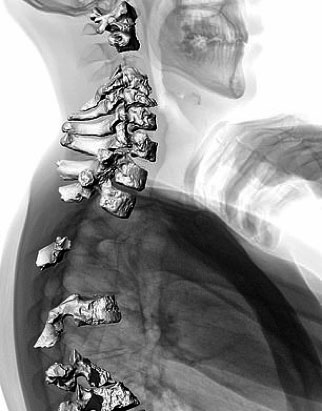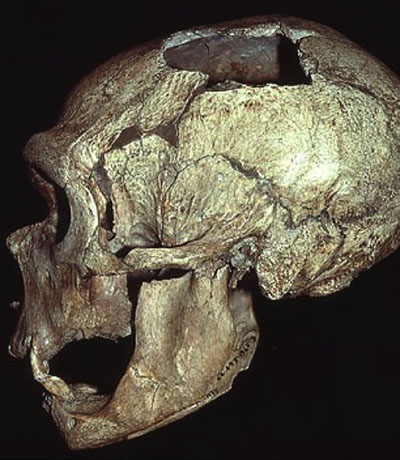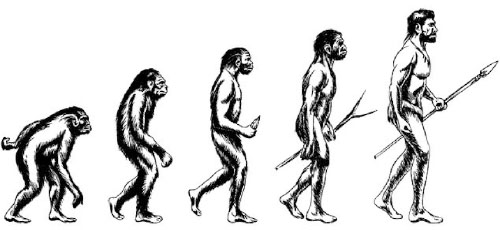Neanderthals did not have Hunched Backs
New findings challenge the view of generally small spinal curvatures in Neanderthals. New study on ancient spine of older male individual discovered in France shows their posture was much like modern humans
Study by
Martin Haeusler, Erik Trinkaus, Cinzia Fornai, Jonas Müller, Noémie Bonneau, Thomas Boeni, and Nakita Frater
Significance
Fully upright and balanced posture is one of the hallmarks of humanity, and it has long been seen as present among all members of the genus Homo. However, recent considerations of Neandertal vertebrae have concluded that these late archaic humans, who were both behaviorally and phylogenetically close to ourselves, lacked fully developed spinal curvatures and must therefore have had precarious postures. Reassessment and virtual reconstruction of the La Chapelle-aux-Saints 1 Neandertal skeletal remains provides direct anatomical evidence that he, and by extension other Neandertals, possessed the usual human lower back and neck curvature (lordosis). It is therefore time to move beyond making Neandertals less human and focus on the subtle shifts in Late Pleistocene human biology and behavior.
Abstract
Although the early postural reconstructions of the Neandertals as incompletely erect were rejected half a century ago, recent studies of Neandertal vertebral remains have inferred a hypolordotic, flat lower back and spinal imbalance for them, including the La Chapelle-aux-Saints 1 skeleton. These studies form part of a persistent trend to view the Neandertals as less “human” than ourselves despite growing evidence for little if any differences in basic functional anatomy and behavioral capabilities. We have therefore reassessed the spinal posture of La Chapelle-aux-Saints 1 using a new pelvic reconstruction to infer lumbar lordosis, interarticulation of lower lumbar (L4-S1) and cervical (C4-T2) vertebrae, and consideration of his widespread age-related osteoarthritis.
La Chapelle-aux-Saints 1 exhibits a pelvic incidence (and hence lumbar lordosis) similar to modern humans, articulation of lumbar and cervical vertebrae indicating pronounced lordosis, and Baastrup disease as a product of his advanced age, osteoarthritis, and lordosis. Our findings challenge the view of generally small spinal curvatures in Neandertals. Setting aside the developmentally abnormal Kebara 2 vertebral column, La Chapelle-aux-Saints 1 is joined by other Neandertals with sufficient vertebral remains in providing them with a fully upright (and human) axial posture.
New Analysis
A new analysis on the vertebrae and pelvis of Neanderthal remains discovered in France during the early 1900s hopes to finally put an end to the debate on their posture.
Throughout the decades, our understanding of the Neanderthal’s stature has varied dramatically; while early reconstructions suggested the ancestor stood with a hunch, others have imagined their spines as straighter than that of the modern human. More recent research has indicated that their spinal curvature may actually have been a lot like our own.
Re-analysis of the La Chapelle-aux-Saints Neanderthal has added even more support to the interpretation that their anatomy was much like that of modern humans’, finding that the spinal curvature fell within the normal human range.
|
The new study shows that their spinal curvature was similar to our own. The Neanderthal spine is shown on right, superimposed on a scan of the modern human back.
‘After more than a century of alternative views, it should be apparent that there is nothing in Neanderthal pelvic or vertebral morphology that rejects their possession of spinal curvatures well within the ranges of variation of healthy recent humans,’ the researchers argue in the new study.
In the paper published to the Proceedings of the National Academy of Sciences, the team used a pelvic reconstruction to investigate the curvature in the spine of the La Chapelle-aux-Saints individual.
The partial skeleton was discovered in 1908, and is said to represent an older male in his sixties or seventies at the time of death. Given his advanced age, the researchers say it was likely the Neanderthal individual suffered osteoarthritis and other age-related degeneration.
 The cervical spine can be seen superimposed over a modern human scan, revealing a similar curvature |
Using the reconstructions, the team examined the angle of the pelvis in relation to the spine, along with the articulations of the cervical and lumbar vertebrae.
And, they found this to be pretty similar to our own. On both accounts, the team says the Neanderthal individual’s spinal curvature fell within the range of normal human posture, with the effects of the degenerative diseases considered.
This, they say, is further supported by other Neanderthal bone discoveries.
According to the researchers, the latest findings add yet another piece of evidence to support Neanderthals’ anatomical similarity to modern humans.
‘This reconsideration of the La Chapelle-aux-Saints remains, as related to vertebral posture and pathology, should emphasize what was accepted half-a-century ago but has been questioned as the relationship between the Neandertals and modern humans has become (uncomfortably to some) close,’ the researchers write.
‘Despite the evident morphological contrasts, there is little, paleontologically or archeologically, to indicate differences in basic functional anatomy and behavioral capabilities between them and their Late Pleistocene modern human neighbors.’
 A partial skeleton (skull shown) was discovered in 1908, and is said to represent an older male in his sixties or seventies at the time of death. |
Throughout the decades, our understanding of the Neanderthal’s stature has varied dramatically. But, recent research has indicated that their spinal curvature may actually have been a lot like our own. A graphic of human evolution is shown (Neanderthal second to last)
The Neanderthals were a close human ancestor that mysteriously died out around 50,000 years ago.
The species lived in Africa with early humans for hundreds of millennia before moving across to Europe around 500,000 years ago. They were later joined by humans taking the same journey some time in the past 100,000 years. These were the original 'cavemen', historically thought to be dim-witted and brutish compared to modern humans.
In recent years though, and especially over the last decade, it has become increasingly apparent we've been selling Neanderthals short. A growing body of evidence points to a more sophisticated and multi-talented kind of 'caveman' than anyone thought possible.
 Throughout the decades, understanding of the Neanderthal’s stature has varied dramatically. |
It now seems likely that Neanderthals buried their dead with the concept of an afterlife in mind. Additionally, their diets and behaviour were surprisingly flexible.
They used body art such as pigments and beads, and they were the very first artists, with Neanderthal cave art (and symbolism) in Spain apparently predating the earliest modern human art by some 20,000 years.
The researchers say the La Chapelle-aux-Saints individual stands as ‘direct anatomical evidence’ that the Neanderthal’s spinal curvature would have resulted in a posture much like that seen in humans today.
Other interpretations, they argue, are just an effort to further distinguish humans from our ancestors, despite the evidence suggesting otherwise.
‘It is therefore time to move beyond making Neandertals less human,’ the researchers write, ‘and focus on the subtle shifts in Late Pleistocene human biology and behavior.’
Source: PNAS – Proceedings of the National Academy of Sciences of the United States of America
and Daily Mail Science
AULIS Online – Different Thinking
